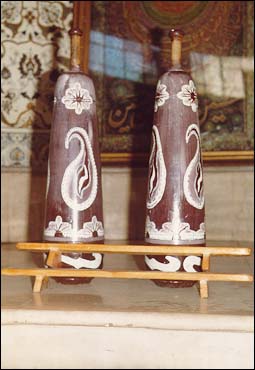 A Pair of Meels |
Among many Pahlavans who traveled to India are Pahlavan Bozorg Pouriyay-e Vali(mid 1300 AD) and Pahlavan Shirdel Kohneh Savar (mid 1300 AD). Their journeys and the accounts of their wrestling matches are documented in Pahlavani books and have been passed from generation to generation in the form of oral history.
Centuries later, the British brought the clubs to Europe and named them "Indian Clubs." The Clubs eventually were brought to the United States of America by European immigrants in the 1800s.
Meels come in different sizes and weights. Two factors that affect exercising with Meels are the height and the weight of a Meel. Usually the light meels weigh about 10-15 lbs. This type of Meel is good for improving one's stamina and they are exercised in 100s of sets. It is reported that Pahlavan Bozorg Hassan Razaz used to exercise meel swinging with 1,000 sets of swings as part of his daily exercise.
On the other hand, heavy Meels are used for building the practitioner's strength. Heavy meels range from 25 lbs. to 60 lbs. each, and the height can be as tall as 4.5 feet. The following picture shows Phalavan Mustafa Toosi, the winner of the Pahlavani Armlet in 1944, 45 and 46, in his later years easily holding a pair of heavy meels. These meels are about 60 pounds each. This specific pair belonged to my grandfather and I have examined them closely myself.
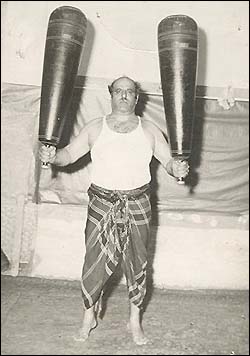 Phalavan Mustafa Toosi holding a pair of heavy meels |
Because Meels are very effective for developing one's upper body strength as well as stamina, many of today's wrestling champions in Iran practice with Meels and other Pahlavani instruments. The following picture shows Jahan Pahlavan Takhti exercising with a typical light-weight pair of Meels.
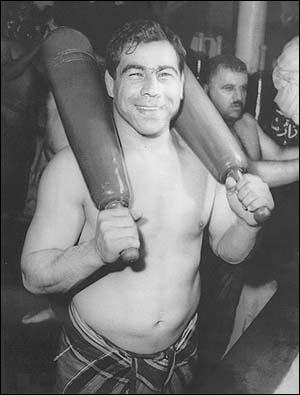 Jahan Phalavan Takhti Olympic Gold Winner (1956), World Wrestling Champion (1959 and 61), and winner of Pahlavani Armlet in 1957, 58 and 59 practising with a pair of light-weight Meels |
Exercising with heavy Meels is part of the Pahlavani tournament that is held each year in Iran. As of 2002, the record of heavy Meels is 63.5 kg (140 lbs.) and for 50 sets.
The material used to prodcue Meels is walnut wood for heavy-weight kinds. To make it even heavier, Meel makers add lead to the bottom of the Meel, but this has to be done with care in order to ensure the symmetry of the Meel in terms of its center of gravity.
In order to learn how to practice Meel swinging, refer to the following illustration. It is important that to the extend possible the Meels must not touch the body. The fingers should hold the head of the Meel where it is shaped into a hand holder. It is advisable that the small finger grasp the bottom of the hand holder.
When holding the Meels, the practitioner's forearm and upper arm must form an angle at about 100 degrees. In step 1, the practitioner holds both Meels vertically in front of his chest and positions himself in the starting point.
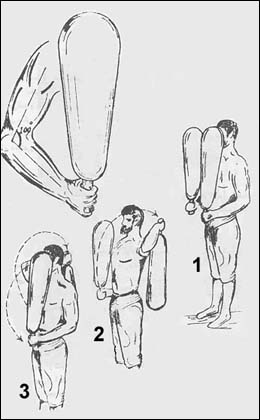 Illustration of Meel Swinging in 3 Steps |
In step 2, he swings one hand (normally the left hand) to his back while keeping the other Meel in the right hand straight in front of himself and in a non-moving position. When the Meel goes in the back, he swings it using his shoulder muscles and brings it back to the straight position in the front. The following picture shows step 2 in the beginning of the meel movement. The left hand is completing its swinging cycle in the back while the right hand is in the front holding the other meel in straight position.
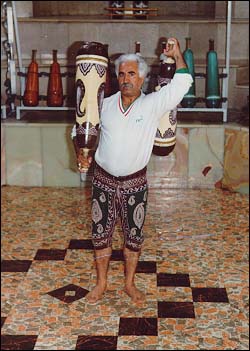 Meel Swinging, Step 2 |
Finally, in step 3 he brings forward the left hand and in effect switches the position of the hands. This time the right hand swings the meel to the back as explained in step 2, and the swinging left hand comes back in the front and the cycle continues.
One cycle of steps 1 through 3 is considered "one set" of meel swinging. Each swing cycle normally takes 3-4 seconds. After some practice, the practitioner can swing the meels in a rhythmic fashion guided by the drum of the Morshed in Zoorkhaneh.
The benefits of Meel swinging are for building shoulder muscles, grip strength, and overall upper body strength.
Another aspect of exercising with Meels is the ability for the practitioner to follow the music of the Morshed inside Zoorkhaneh. Almost all Pahlavani exercises are accompanied with rhythmic music. Morshed is the person who chants and plays the drum while guiding the group practitioners.
Because Meel swinging is a group exercise, the music coordinates both the individual moves and those of the group. Secondly, Morshed's rate of playing the drum will determine the rate of swinging the Meels back and forth. So as he drums faster, the swings become faster.
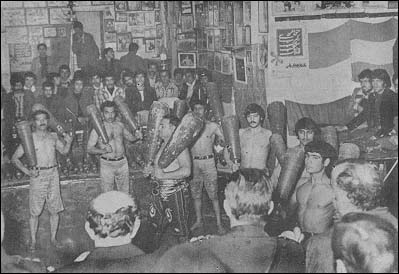 Exercising with Meels in a group |
One type of ritual that is not a part of Pahlavani tradition is joggling light meels. This type of demonstration or entertainment became popular within the last 70 years in many Zoorkhanehs in Iran. This theatrical exercise is not part of Pahlavani and has no Pahlavani characteristics. In recents years the Pahlavani Federation in Iran has discouraged joggling with Meels in Zoorkhanehs.
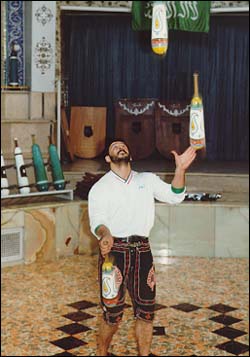 Theatrical Meel Joggling, which is not part of Pahlavani tradition. |
E-mail: info@Pahlavani.com